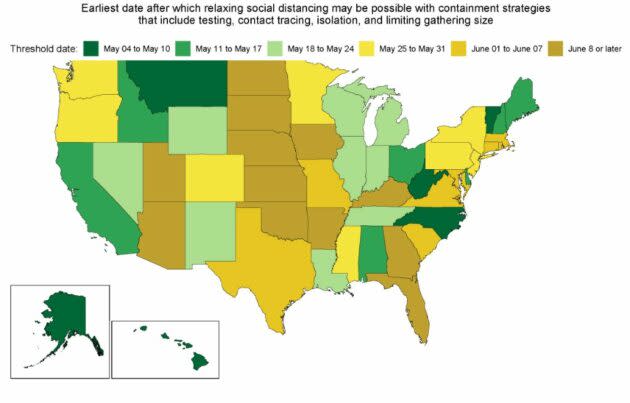Coronavirus computer modelers revise their dates for easing state shutdowns
The latest computer projections from the University of Washington’s Institute for Health Metrics and Evaluation deliver a double dose of discouragement about the course of the coronavirus outbreak, especially for those in the institute’s home state.
Today’s assessment estimates that conditions could be acceptable for Washington state to loosen its shelter-at-home restrictions on May 26 — which is eight days later than Friday’s estimate. Moreover, that assessment assumes that public health officials will have adequate resources for testing patients, conducting contact tracing and isolating those who become infected — which is not assured.
The other discouraging word is that the projected U.S. death toll through Aug. 4 has been raised, from 60,308 to 65,976. There’s a wide interval of uncertainty to that figure: The institute says it could end up as low as 45,375 or as high as 124,120.
Epidemiologists at the IHME based their projected “threshold” dates for loosening restrictions on the date when the model suggests the rate of new daily infections will fall below 1 per million residents in a given state. They acknowledged that the dates are later, on average, than they were on Friday.

Coronavirus Live Updates: The latest COVID-19 developments in Seattle and the world of tech
“The main driver of these later predictions is the increase in reported deaths since the last release, as well as predictions of longer (and flatter) epidemic peaks for several states,” they wrote in today’s status report.
The first state to hit its threshold date is Montana, on May 1. The latest state on the list is right next door: North Dakota has a projected threshold date of July 12.
Like every computer model, IHME’s projections make a lot of assumptions about the extent of shelter-at-home orders and how closely they’re followed. “These projections could change as new data become available or different policies are implemented,” the institute said.
If some states loosen their restrictions before the threshold date, that would presumably change the model’s assessments for the eventual number of cases and deaths — and probably not in a good way.
Some experts have criticized the IHME’s methods and its models, complaining that the projections vary too widely from week to week and may leave policymakers either confused or complacent. The institute’s director, Christopher Murray, acknowledged last week that the projections were likely to shift earlier or later depending on the data.
“As the quality and quantity of our data increase, we will offer policymakers refined views of the pandemic’s course,” Murray said.
For the record, the current modeling projects 779 total deaths in Washington state due to COVID-19 by Aug. 4, compared with 23,741 deaths in New York and 65,976 deaths in the nation. Johns Hopkins University’s coronavirus tracker currently reports 824,147 confirmed COVID-19 cases and 45,039 deaths in the United States. Over the past few days, the cumulative death toll in North America has been growing by roughly 2,000 daily.
More from GeekWire:
Another month? Computer modelers estimate how much longer coronavirus shutdowns should last
King County public health officials will be distributing 20,000 coronavirus test kits
Univ. of Washington researchers predict 80,000 COVID-19 deaths in U.S. by July
As Washington state COVID cases keep falling, here’s the data driving the ongoing ‘stay home’ order
